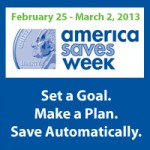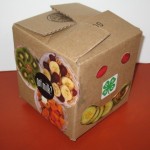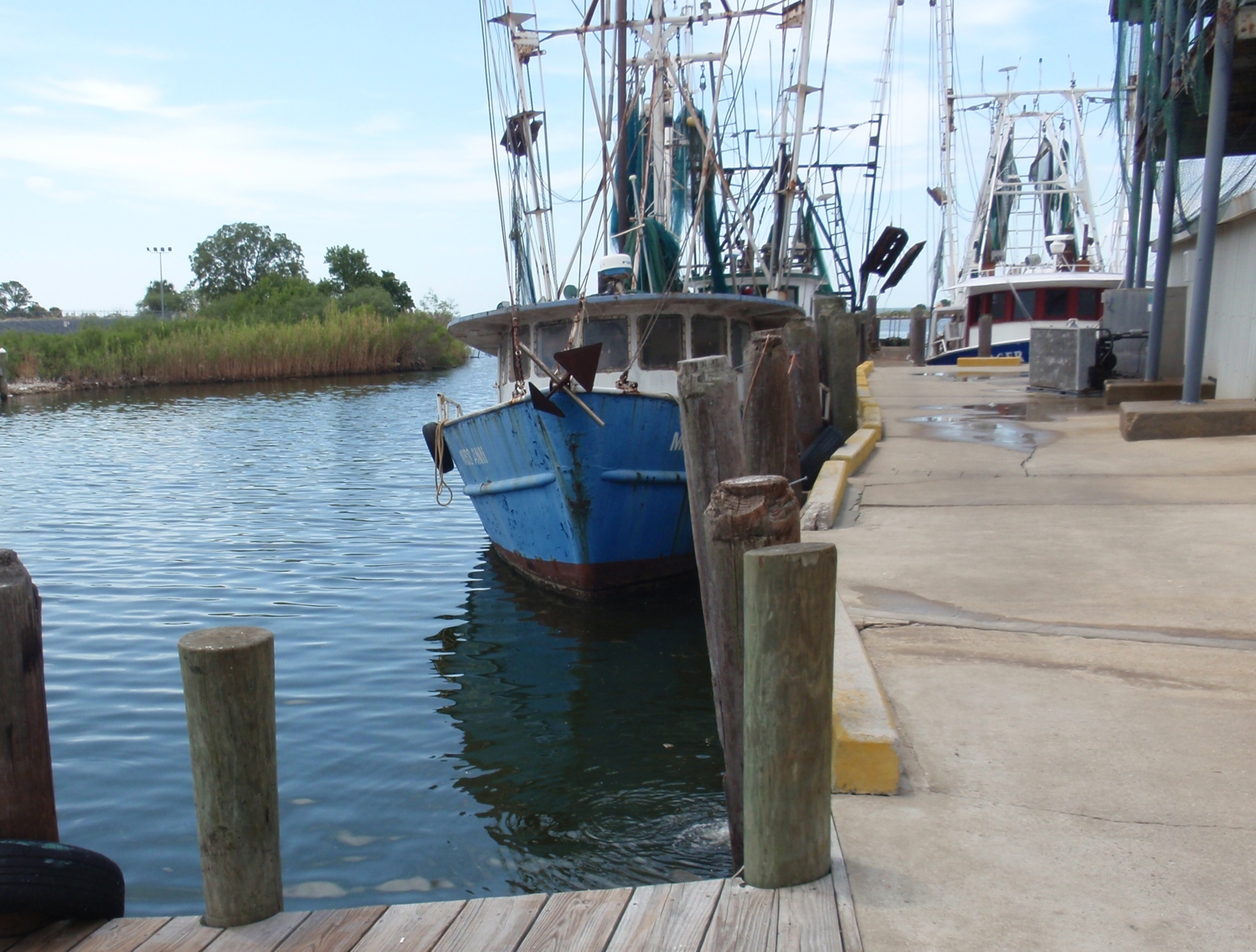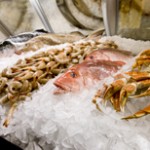by Elaine Courtney | Feb 18, 2013
Saving money can be easy or it can be extremely difficult. Why should you save? To set aside money you could spend today…so you can spend it tomorrow! Ask yourself some hard questions:
What would happen if…
- You lost your job?
- You got sick?
- You had an emergency?
How will you pay for big purchases? Will you be able to retire?
 What makes the difference? Understanding the Keys to Successful Savings! The theme for Saves Week focuses on these three key components of savings: Set a Goal, Make a Plan, Save Automatically.
What makes the difference? Understanding the Keys to Successful Savings! The theme for Saves Week focuses on these three key components of savings: Set a Goal, Make a Plan, Save Automatically.
Today let’s focus on the first part of Successful Saving–Set a Goal.
What do you want? Are you searching for ways to save money to pay off late bills or keep up with this month? Do you need to go to the dentist, buy or fix things for your home and family, pay for day care, or train for a better job? Do you want to buy a bicycle for your kids and/or send them to college? Without clear goals, you don’t know where you’re going.
Financial goals identify what you want to do with your money. Goals give you direction. They give you a purpose for the way you spend your money
 What constitutes a goal? A statement such as “I want to save money” is too vague. It becomes a realistic financial goal by adding a dollar amount, and a time frame. For instance, “I want to save $25 a week for 12 months”. An actual goal, however, would depend on an individual’s or family’s income and values.
What constitutes a goal? A statement such as “I want to save money” is too vague. It becomes a realistic financial goal by adding a dollar amount, and a time frame. For instance, “I want to save $25 a week for 12 months”. An actual goal, however, would depend on an individual’s or family’s income and values.
Make your goals SMART! Creating SMART goals gives us an action plan for reaching the goals we set.
Specific -Write down exactly what it is you want to accomplish. For example, instead of writing “I want to pay off credit card debt,” write, “I want to pay off the $5000 balance on my Visa Card.” Instead of writing, “I want to start an emergency fund,” write, “I want to save $1000 in an emergency fund.
Measurable –Financial goals are measured by a dollar amount, and you want to be able to see the progress you are making toward your goal. In the example we used before, if I want to pay off $5000 in credit card debt, I need to figure out how much money I need to pay per month, based on my deadline (this is the Time-Bound part- we’ll get to it shortly). If I wanted to pay it off in 12 months, I would need to pay around $420 per month (plus a little extra to cover interest and fees). Each month, I will see measurable progress toward my goal as my balance decreases.
Adaptable –With finances, we always need to be adaptable. Things change, life happens, emergencies come up, and we have to change our plans. Make sure that your goals are adaptable for changes in your financial situation. For instance, if you figure out that you want to pay $300 per month toward paying down your credit card debt, but then you have some unexpected expenses one month, you may have to pay less this month and either make up for it next month or stretch out your timeline.
Realistic –One of the biggest reasons we do not reach our financial goals is because we set the bar too high. If I only have $100 extra dollars in my budget, but I commit to paying $300 toward my credit card bill, I am setting myself up for failure. I could make this goal more realistic by 1) lowering the amount I plan to pay toward my credit card bill and stretching out the time I will be paying it down or 2) looking for other places in my budget where I can cut expenses in order to make this payment possible.
Time-Bound –Set deadlines for your financial goals! If you are anything like me, tasks without deadlines get pushed farther and farther down my to-do list. If you are serious about meeting your financial goals, set deadlines by which you want to accomplish them. This will also help you to determine how to measure your goals (see making your goals measurable above.
The second key to successful savings is to MAKE A PLAN. No matter what your financial goals are, it is important to map out a plan for achieving success.
The final key is to SAVE AUTOMATICALLY. Have part of your paycheck deposited into savings or transferred from checking to savings. You can also participate in retirement accounts that have automatic deposits made each pay period. This makes it easy to save and removes the temptation of having that money easily accessible.
As part of SAVES WEEK, there will be an on-line presentation and discussion about the Keys to Successful Saving on Tuesday, February 26, 11:30-12:30 CST. This might be just the motivation you need to get started saving!
February 26
3 Keys to Successful Savings –Create SMART goals, find money to save, make a savings plan, and choose the right savings accounts to reach your goals. http://bit.ly/3KeySaves. Participating is easy and free! We will send you a reminder email and the login instructions! Hope you’ll join me!
Don’t forget to join other savers…Become an Okaloosa Saver http://bit.ly/Al9BuH or Florida Saver at http://fycs.ifas.ufl.edu/Extension/FinancialManagement/FloridaSaves/Florida_Saves_Enrollment_Form.pdf.
Additional webinars will be held during Saves Week (all times are 11:30-12:30 CST):
February 27
Goal – Based Investing – Learn how to use a goal-based investment strategy to achieve financial goals. Learn to effectively develop a financial plan and choose investment accounts that work for particular goals. http://bit.ly/UFINVest
February 28
Tips for Tax Preparation & Filing – Review options for free tax filing, tax credits & tax deductions. Tips to analyze returns to help with financial decisions. http://bit.ly/TaxFil
Prepared by: Elaine A. Courtney
Family & Consumer Sciences Extension Agent
UF/IFAS Extension-Okaloosa County
850-683-8431
ecourtne@ufl.edu
by Elaine Courtney | Feb 18, 2013
 Setting a goal is the first step in taking charge of your finances. However, staying on track to meet that goal can be hard! The America Saves Challenge will help you meet your goals by providing daily encouragement and challenge!
Setting a goal is the first step in taking charge of your finances. However, staying on track to meet that goal can be hard! The America Saves Challenge will help you meet your goals by providing daily encouragement and challenge!
The 2013 America Saves Challenge is part of America Saves Week (February 25-March 2, 2013), a time set aside annually to promote good savings behavior. The “2013 America Saves Challenge” is a free five-week program, held from Sunday, February 24, through Saturday, March 30, 2013. There will be weekly prizes and final challenge awards at the end of program.
You may enroll online at http://rutgers.ancc.net/ (Rutgers Cooperative Extension Small Steps to Health and Wealth™ Challenge Web site)
- Set up a user name and password and
- Download a one-page user’s guide with instructions about how to proceed.
- Enroll in the Challenge titled “2013 America Saves Challenge.” This challenge will be among a list of names of online challenges that are currently available.
When people track their behavior and measure how they are doing, they are often inspired to do better and achieve positive results. Participants in the America Saves Challenge are “on their honor” to report their activities accurately. If they “cheat” on reporting their points, they are only cheating themselves by not following the recommended financial practices.
The America Saves Challenge is based on the performance of ten recommended financial practices. Ten points are given for performing each one. (Maximum of 700 points per week) “The Challenge is a great way to convert personal financial goals, like saving money and learning about investing, into daily action steps,” notes Dr. Barbara O’Neill, Extension Specialist in Financial Resource Management for Rutgers.
Participants will receive daily motivational messages. Paper tracking forms are available to keep track of daily activities.
Doing even one of the ten recommended daily financial practices is a great way to get started on your financial goals. The more America Saves Challenge activities you do, the better your financial progress.
To participate in the America Saves Challenge, visit http://rutgers.ancc.net/, register an account, and enroll in the “2013 America Saves Challenge.”
For additional information, contact Elaine Courtney, University of Florida-IFAS/Okaloosa Extension @ 850-683-8431 or your local Cooperative Extension Office.
by Heidi Copeland | Feb 13, 2013
http://hp2010.nhlbihin.net/healthyeating/pdfs/KTB Family Cookbook 2010.pdf

Download the deliciously healthy family meals cookbook
What timeless words of wisdom!
More recently, researchers at Rutgers University conducted a Meta study looking at 68 studies that examined the relationship between family meals, eating habits, and children’s health. Specifically, they wanted to know if there was a correlation between family meals and obesity.
Interestingly, because so many of the studies outcomes were in general agreement, it makes sense to keep them in mind. The data suggests that family mealtime does indeed have a wealth of benefits, especially for children.
When families make mealtimes more of a priority, they tend to pay more attention to what is served. Children who have more family meals get more of the nutrient-rich foods that build strong bodies and smart brains: more fruits, veggies, lean meats, and low-fat milk; fewer fried foods and soft drinks.
Additionally, researchers found that the quality time spent together during a family meal helps build relationships as well as foster healthy eating habits such as eating slowly, enjoying a variety of foods, and stopping when comfortably satisfied rather than overstuffed.
Remember, the research does not promise if your family eats together your children will be magically perfect; it is the sharing between family members that is important.
Make as many family meals as possible a priority. By making some healthy and realistic goals you have a plan for success. How?
Step 1: Get Ready
Involve all family members in the planning by allowing each person a chance to talk about their food preferences.
Step 2: Plan the main courses
Plan for a week the foods your family enjoys, your budget, the time you have to prepare it as well as nutrition.
Step 3: Stock the kitchen with staples
Stocking the pantry, refrigerator and freezer with essential ingredients makes it easy to prepare a quick and tasty meal.
Step 4: Make the cooking easy
Family meals do not have to be a formal dinner. Try strategies that work for you to spend less time preparing and more time enjoying a family meal.
Example: Save preparation time using ready-to-eat fresh vegetables or salads.
Make family mealtimes a normal part of your family life. This very simple activity can help to sustain a family’s health and culture, connect each generation to each other at the same time providing indispensable life skills, as well as the deeply rooted satisfaction in making something with your own family’s hands.
Try these websites for quick an easy family friendly recipes.
http://edis.ifas.ufl.edu/topic_healthcooking
http://oregonstate.edu/dept/kbrec/family-friendly-recipes
http://hp2010.nhlbihin.net/healthyeating/pdfs/KTB_Family_Cookbook_2010.pdf
by Kendra Hughson | Nov 21, 2012
 From Halloween to the New Year, most people struggle to control their eating. The average American gains about one pound during the holiday season. Some gain even more. While this is less than the holiday weight gain amounts that get widely reported, most people never lose this excess weight so the pounds accumulate, resulting in obesity or overweight.
From Halloween to the New Year, most people struggle to control their eating. The average American gains about one pound during the holiday season. Some gain even more. While this is less than the holiday weight gain amounts that get widely reported, most people never lose this excess weight so the pounds accumulate, resulting in obesity or overweight.
The 2010 USDA Dietary Guidelines for Americans suggest reducing fat, sodium, and added sugar. Simple substitutions can make your traditional holiday recipes lower in fat and calories without losing the taste. With a little bit of planning and modification, you can create a healthier version of many holiday foods and recipes.
A recipe is actually a chemical formula and each ingredient has a function that results in the taste, texture, and appearance of the end product. It’s important to know what each ingredient does, how it can be changed, and by how much in order to keep the final product as close to the original as possible.
Research has shown that when more fiber is added, when fat and cholesterol is reduced, and/or when less sugar and salt are used, most people either don’t notice much difference between the original and healthier version or they accept the new product. So try out some of the suggestions below to makeover your favorite recipes. Don’t tell anyone you changed it to see if they notice. Contact the UF/IFAS Extension office in your county for more information.
To decrease fat and calories:
| Instead of this: |
Try this: |
| Shortening, butter, margarine |
Use ¼ less. Replace melted butter or margarine with equal amounts of liquid oil. When baking, replace half of the butter, shortening, or oil with applesauce or prune puree (may reduce baking time by 25%). |
| Full fat sour cream, cottage cheese, Ricotta cheese or cream cheese |
Use non-fat or low-fat varieties. Use part-skim Ricotta cheese. |
| Eggs |
Use egg whites (usually 2 egg whites for every egg) or use ¼ cup egg substitute. |
To decrease sugar:
| Instead of this: |
Try this: |
| Sugar |
Reduce sugar by ¼ to ⅓ in baked goods and desserts. Add cinnamon, vanilla, or almond extract for flavoring. Do not remove sugar in yeast breads. Experiment with artificial sweeteners. |
| Syrup |
Use pureed fruit, such as no-sugar-added applesauce, or sugar-free syrup |
To decrease sodium:
| Instead of this: |
Try this: |
| Salt |
Omit salt or reduce salt by ½ in most recipes (except in products with yeast) |
| Seasoning salt or spice mixes with salt |
Buy salt-free seasonings. Catsup, chili sauce, chili powder, bouillon cubes, barbecue sauce, soy sauce, meat tenderizers, and Worcestershire sauce are high in sodium. Use herbs, spices, lemon juice, or vinegar instead. |
Source: “Modifying a Recipe to be Healthier” The Ohio State University Extension
by Angela Hinkle | Oct 23, 2012
 Those are familiar words for most of us with kids. Though they are not really starving, most children do need a little afternoon boost when they come home from school. It may have been hours since lunch and dinner won’t be ready for a while. A healthy snack is usually just the right answer.
Those are familiar words for most of us with kids. Though they are not really starving, most children do need a little afternoon boost when they come home from school. It may have been hours since lunch and dinner won’t be ready for a while. A healthy snack is usually just the right answer.
When planning afterschool snacks, think of them as the fourth meal of the day or as a mini-meal. Hopefully, you wouldn’t plan a dinner of just potato chips or candy, so why plan snacks that way? Use the food groups from MyPlate to help you plan healthy, ready-to-eat snacks from each food group.
- Fruit – Have a bowl of fruit on the counter always at the ready. Keep a pre-cut fruit salad or peeled oranges in the refrigerator. Make 100% fruit juice popsicles.
- Vegetables – Keep cut up veggies available in plastic zippered bags with kid-friendly dips like ranch dressing to go with them.
- Protein – A variety of nuts and seeds is always good to have on hand. Hard boiled eggs offer great protein power as well.
- Dairy – String cheese and yogurt cups are terrific dairy sources.
- Whole Grains – Whole grain crackers, popcorn, and granola mix add plenty of crunch.
 “Easy” and “available” are the key planning points to remember. Designate a snack area in the refrigerator or pantry. Decorate a personalized snack box for each child filled with favorite healthy snacks. A healthy variety of snacks always at the ready holds our child’s interest, provides the much needed energy to close the gap between lunch and dinner, provides nutrients they may not have gotten from other meals in the day, and keeps them from … well, starving.
“Easy” and “available” are the key planning points to remember. Designate a snack area in the refrigerator or pantry. Decorate a personalized snack box for each child filled with favorite healthy snacks. A healthy variety of snacks always at the ready holds our child’s interest, provides the much needed energy to close the gap between lunch and dinner, provides nutrients they may not have gotten from other meals in the day, and keeps them from … well, starving.

by Dorothy C. Lee | Jul 25, 2012
This may sound like a fish story, but it’s true! People are eating more fish and shellfish than ever before! While seafood has always been popular in the South as a whole, no area is more graciously endowed with an abundance of fresh seafood products than the northern Gulf Coast. The warm waters of the Gulf of Mexico abound with many delicious saltwater fish, as well as a plentiful supply of shrimp, crabs, scallops, and oysters.
of shrimp, crabs, scallops, and oysters.
Fish and shellfish have become an even more important part of the diet as people turn to more healthful eating. People are choosing fish and shellfish more for several other reasons as well—it is economical, high in nutritive value, quick and easy to prepare, versatile, and, best of all, seafood is great-tasting.
Buying seafood can be a daunting process because of the huge variety of market forms available, yet with general guidelines you can easily learn to recognize quality and freshness.
Always purchase your fish and shellfish from a reliable dealer who will stake his reputation on the quality and freshness of his merchandise. Seafood is a highly perishable commodity, and therefore should be purchased as near to the time of preparation as possible, and as close to the time the catch was made, if that information is available.
When buying fish, look for bright, clear, bulging eyes; reddish or pink gills; tight, shiny scales; firm, elastic flesh that springs back when pressed; and a pleasant salt-water-like odor. Fresh shrimp should be slightly green in color and firm to the touch. Shucked oysters should be plump with no evidence of shrinkage. The liquid in which oysters are packed should be clean, fresh, and sweet-smelling. Scallops are usually sold shucked. Select scallops that are cream-colored rather than white.
Fish and shellfish are best if cooked the day of purchase, but can be stored no more than two days in the coldest part of the refrigerator, preferably on ice. Frozen fish and shellfish should be kept solidly frozen until ready to thaw. Frozen seafood will remain fresh for four to six months. Cook seafood immediately upon thawing. Never refreeze seafood.
Most fish and shellfish can be cooked using a variety of methods. Seafood can be broiled, grilled, deep-fried, poached, steamed, baked, panfried, and sautéed. Particular care must be taken not to overcook seafood.
Many seafood aficionados/enthusiasts prefer flavoring their dishes with only small amounts of salt, pepper, and occasionally lemon, yet the delicate taste of seafood blends exceptionally well with a variety of herbs, spices and seeds, as long as those seasonings are used sparingly so as not to overwhelm the flavor of the seafood.
So the next time you are in the neighborhood of your favorite seafood market, stop in. Remember that fish and shellfish from the Gulf are nutritious, economical, quick and easy to prepare, and taste great. And that’s no fish story!
SWEET-AND-SOUR SHRIMP
1 pound shrimp, cooked, peeled, and deveined
¼ cup margarine
1 onion, thinly sliced
1 bell pepper, diced
1 (8¼-ounce) can pineapple chunks
½ cup white vinegar
¼ cup white sugar
2 tablespoons cornstarch
1 tablespoon soy sauce
½ teaspoon dry mustard
1 teaspoon pepper
¼ teaspoon salt
Cut shrimp into bite-sized pieces. Heat electric wok to 350°F and melt margarine; cook onions and bell peppers until they are crisp-tender.
Drain pineapple, reserving syrup for sauce. In a large bowl blend together pineapple syrup, vinegar, sugar, cornstarch, soy sauce, dry mustard, pepper, and salt. Mix well. (Note: a whisk will aid in thoroughly blending ingredients.)
Stir sauce into sautéing onion and bell pepper; cook until sauce thickens. Gently stir in pineapple chunks and shrimp. Heat until pineapple and shrimp are hot. Serve over hot rice.
Author: Dorothy C. Lee, Family and Consumer Sciences Agent, UF/IFAS Escambia County Extension
![]() What makes the difference? Understanding the Keys to Successful Savings! The theme for Saves Week focuses on these three key components of savings: Set a Goal, Make a Plan, Save Automatically.
What makes the difference? Understanding the Keys to Successful Savings! The theme for Saves Week focuses on these three key components of savings: Set a Goal, Make a Plan, Save Automatically. What constitutes a goal? A statement such as “I want to save money” is too vague. It becomes a realistic financial goal by adding a dollar amount, and a time frame. For instance, “I want to save $25 a week for 12 months”. An actual goal, however, would depend on an individual’s or family’s income and values.
What constitutes a goal? A statement such as “I want to save money” is too vague. It becomes a realistic financial goal by adding a dollar amount, and a time frame. For instance, “I want to save $25 a week for 12 months”. An actual goal, however, would depend on an individual’s or family’s income and values.






